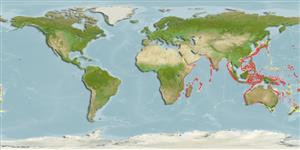>
Scombriformes (Mackerels) >
Nomeidae (Driftfishes)
Etymology: Cubiceps: Latin, cubus = cube + Latin, ceps = head (Ref. 45335).
Eponymy: Thomas Whitelegge (1850–1927) was an English naturalist who emigrated (1883) to Sydney, Australia, where he joined the Linnean Society of New South Wales. [...] (Ref. 128868), visit book page.
More on author: Waite.
Environment: milieu / climate zone / Mức độ sâu / distribution range
Sinh thái học
Biển Sống nổi và đáy; Mức độ sâu 180 - 550 m (Ref. 9834), usually 300 - 450 m (Ref. 9834). Tropical
Indo-West Pacific: probably widely distribtuted in tropical and warm-temperate waters of the Indian Ocean (excluding the Red Sea) and from Japan to eastern Australia.
Bộ gần gũi / Khối lượng (Trọng lượng) / Age
Chín muồi sinh dục: Lm ? range ? - ? cm
Max length : 21.0 cm SL con đực/không giới tính; (Ref. 54802); common length : 15.0 cm SL con đực/không giới tính; (Ref. 9834); Khối lượng cực đại được công bố: 110.00 g (Ref. 54802)
Các tia vây lưng cứng (tổng cộng) : 11 - 13; Các vây lưng mềm (tổng cộng) : 17 - 21; Tia cứng vây hậu môn: 2 - 3; Tia mềm vây hậu môn: 17 - 20; Động vật có xương sống: 31 - 32. Light to dark brown, fins dark; eye blue; young with dark band near base of tail (Ref. 4412). Body moderately elongate and compressed. Ventral profile very convex. Caudal peduncle moderately deep, compressed, lacking scutes or keels. Snout blunt, forehead slightly arched. Mouth small, terminal or slightly inferior, barely reaching beyond anterior margin of eye. Upper jaw not protractile, almost totally covered by lacrimal (preorbital) bone when mouth closed. Eye large , its diameter subequal to snout length, slightly smaller than interorbit, centered on upper half of head. Low ridge extending over eye. Jaw teeth small, in a single series. Palatine teeth more elongate, in single row. Vomerine tooth patch small. Single median row of teeth on tongue (Ref 9834).
Body shape (shape guide): fusiform / normal.
Found near continental and insular margins (Ref. 9834), in deep water on continental slopes (Ref. 30573). Adults are characterized by a demersal mode of life in the upper continental slope, between 180 and 800 m (commonly 300-450 m) and the young are found in mid-water layers (Ref. 54802). Feeds mainly on salps (Ref. 33689). Marketed fresh and could also be used as fishmeal or paste (Ref. 9502).
Life cycle and mating behavior
Chín muồi sinh dục | Sự tái sinh sản | Đẻ trứng | Các trứng | Sự sinh sản | Ấu trùng
Haedrich, R.L., 1986. Nomeidae. p. 846-850. In M.M. Smith and P.C. Heemstra (eds.) Smiths' sea fishes. Springer-Verlag, Berlin. (Ref. 4412)
IUCN Red List Status (Ref. 130435: Version 2025-1)
Threat to humans
Harmless
Human uses
Các nghề cá: có khả năng có lợi
Các công cụ
Special reports
Download XML
Các nguồn internet
Estimates based on models
Preferred temperature (Tài liệu tham khảo
123201): 8.8 - 15.4, mean 11.1 °C (based on 249 cells).
Phylogenetic diversity index (Tài liệu tham khảo
82804): PD
50 = 0.5010 [Uniqueness, from 0.5 = low to 2.0 = high].
Bayesian length-weight: a=0.00955 (0.00409 - 0.02231), b=3.10 (2.89 - 3.31), in cm total length, based on LWR estimates for this (Sub)family-body shape (Ref.
93245).
Mức dinh dưỡng (Tài liệu tham khảo
69278): 3.5 ±0.0 se; based on diet studies.
Thích nghi nhanh (Tài liệu tham khảo
120179): Chiêù cao, thời gian nhân đôi của chủng quần tối thiểu là dưới 15 tháng (Preliminary K or Fecundity.).
Fishing Vulnerability (Ref.
59153): Low vulnerability (16 of 100).
🛈
